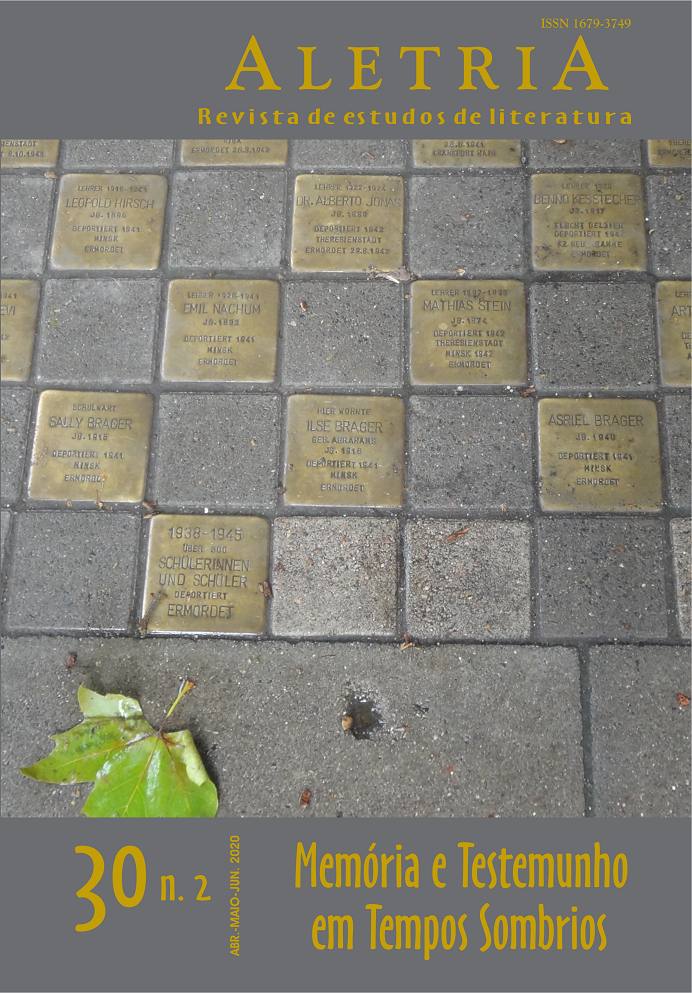Literature and Resistance in Avalovara, by Osman Lins
DOI:
https://doi.org/10.35699/2317-2096.2020.21944Keywords:
Brazilian Literature, Osman Lins, Avalovara, violence, resistanceAbstract
The paper discusses the character known only by the symbol ఠ, from the novel Avalovara by Osman Lins. It proposes that the character can be read as a confluence of different meanings which open to infinity and can also be read as an allegory of the resistance literature itself – in this case, resistance against the Brazilian military dictatorship. The notions of violence and authoritarianism proposed by Hannah Arendt are brought to light throughout the discussion, as well as Antoine Compagnon’s remarks about the potential of literature to turn against oppression. In its argumentative course, the paper also discusses propositions by, among others, Maria Aracy Bonfim and Elizabeth Hazin, about the features of the character in question; and Jaime Ginzburg, about the marks that violence leaves on Literature.
Downloads
References
ARENDT, Hannah. Origens do totalitarismo. [S. l.: s. n.], 1979. Disponível em: http://www.dhnet.org.br/direitos/anthist/marcos/hdh_arendt_origens_totalitarismo.pdf. Acesso em: 22 jun. 2019.
ARENDT, Hannah. Sobre a violência. Tradução de André Duarte. Rio de Janeiro: Relume Dumará, 2004.
BONFIM, Maria Aracy. Conteúdo e continente – o corpo de ఠ: poética e criação em Avalovara. In: HAZIN, Elizabeth (org.). Linscritura: limiares da escrita osmaniana. Rio de Janeiro: Vieira & Lent: CNPq, 2014. p. 61-69.
BORGES, Jorge Luis. O jardim das veredas que se bifurcam. In: ______. Ficções. Tradução de Carlos Nejar e Maria Carolina de Araújo. São Paulo: Globo, 1999. p. 44-51.
CANDIDO, Antonio. Prefácio. In: LINS, Osman. Avalovara. São Paulo: Edições Melhoramentos, 1973. p. 9-11.
COMPAGNON, Antoine. Literatura para quê?. Tradução de Laura Taddei Brandini. Belo Horizonte: Editora UFMG, 2009.
DELEUZE, Gilles. GUATTARI, Félix. Mil Platôs: capitalismo e esquizofrenia 2. Tradução de Ana Lúcia de Oliveira, Ana Guerra Neto e Célia Pinto Costa. São Paulo: Editora 34, 2011. v. 1.
ECO, Umberto. Semiótica e filosofia da linguagem. Tradução de Mariarosaria Fabris e José Luiz Fiorin. São Paulo: Ática, 1991.
GINZBURG, Jaime. Crítica em tempos de violência. 2010. 300f. Tese (Livre Docência em Literatura Brasileira) – Faculdade de Filosofia, Letras e Ciências Humanas, Universidade de São Paulo, São Paulo, 2010.
GUATTARI, Felix; ROLNIK, Suley. Micropolítica: cartografias do desejo. 4. ed. Petrópolis: Vozes, 1996.
HAZIN, Elizabeth. Como um segredo de um cofre: reflexões acerca de uma personagem feminina em Osman Lins. Revista Ângulo/Caderno do Centro Cultural Teresa D’Ávila, Lorena (SP), n. 121/122, p. 47-51, abr./set. 2010. Disponível em: http://www.unifatea.edu.br/seer/index.php/angulo/article/viewFile/737/505. Acesso em: 19 ago. 2018.
HAZIN, Elizabeth. Palindromia. In: HAZIN, Elizabeth; BARRETO, Francismar Ramírez; BONFIM, Maria Aracy (org.). Palindromia. Brasília: Siglaviva, 2014. p. 105-115.
LINS, Osman. Avalovara. São Paulo: Edições Melhoramentos, 1973.
LINS, Osman. Evangelho na Taba: novos problemas inculturais brasileiros. São Paulo: Summus, 1979.
LINS, Ronaldo Lima. Violência e literatura. Rio de Janeiro: Tempo Brasileiro, 1990.
PAGANINE, Joseana. A poética osmaniana: entre a alegoria e o símbolo. In: HAZIN, Elizabeth (org.). Linscritura: limiares da escrita osmaniana. Rio de Janeiro: Vieira & Lent; CNPq, 2014. p. 239-255.
TODOROV, Tzvetan. Linguagem e literatura. In: ______. As estruturas da narrativa. Tradução de Leyla Perrone-Moisés. São Paulo: Perspectiva, 2013. p. 53-65.
Downloads
Published
How to Cite
Issue
Section
License
Copyright (c) 2020 Raul Gomes da Silva, Ramiro Giroldo (Autor)

This work is licensed under a Creative Commons Attribution 4.0 International License.
Authors who publish with this journal agree to the following terms:Authors retain copyright and grant the journal right of first publication with the work simultaneously licensed under a Creative Commons Attribution Non-Commercial No Derivatives License that allows others to share the work with an acknowledgement of the work's authorship and initial publication in this journal.Authors are able to enter into separate, additional contractual arrangements for the non-exclusive distribution of the journal's published version of the work (e.g., post it to an institutional repository or publish it in a book), with an acknowledgement of its initial publication in this journal.Authors are permitted and encouraged to post their work online (e.g., in institutional repositories or on their website) prior to and during the submission process, as it can lead to productive exchanges, as well as earlier and greater citation of published work (See The Effect of Open Access).





